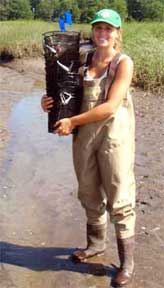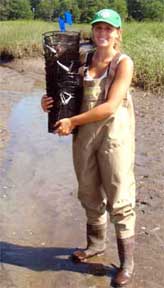 KINGSTON, R.I. – January 13, 2011 – University of Rhode Island junior Tiffany Lewis has had her hands full over the last six months, slogging through marshes for 12 hours at a time, dissecting tiny fish and conducting laboratory analyses.
KINGSTON, R.I. – January 13, 2011 – University of Rhode Island junior Tiffany Lewis has had her hands full over the last six months, slogging through marshes for 12 hours at a time, dissecting tiny fish and conducting laboratory analyses.
It was her first experience conducting fieldwork for an environmental study, and she wasn’t quite sure what she was getting herself into.
“I guess I had a more glorified vision in my head of what fieldwork is all about,” she said with a smile. “It wasn’t at all what I was expecting. But it was still a good time.”
Her research, in collaboration with URI graduate student Kimberly Lellis-Dibble, is aimed at understanding whether Phragmites australis, an invasive reed that is outcompeting native salt marsh grasses, is harming coastal wetlands and whether efforts to remove it are restoring habitat value for resident fish populations.
“We really want to know what Phragmites is doing to the fish, the soil, the other plants in coastal marshlands, the food web as a whole, to see if it is really causing the problems that most people think it is. That way people can begin to manage their land and restoration efforts more effectively,” said Lewis, who competed on the varsity swim team at Mt. St. Charles Academy and earned a prestigious Centennial Scholarship to attend URI.
So she visited eight marsh sites throughout New England to collect samples of plants and fish to evaluate the impact the invasive grass is having. She focused much of her time on mummichogs, a small fish that lives among the reeds, by weighing and measuring them, checking them for parasites, evaluating their growth patterns, and studying their lipid content as a measure of overall health.
“It’s just the first year of this project, so we don’t have any solid conclusions yet,” the URI student explained. “We’re still analyzing a lot of the data. Hopefully we’ll find that fish in restoring salt marshes are healthier and the ecosystem provides better habitat than at sites where the Phragmites is still abundant. That will mean that the millions of dollars that have gone into restoring marshes around the country is truly making a difference.”
Lewis’s research was supported by the URI Coastal Fellows Program, a unique initiative designed to involve undergraduate students in addressing current environmental problems. Now in its 15th year, it is based at URI’s College of the Environment and Life Sciences. Students are paired with a mentor and research staff to help them gain skills relevant to their academic major and future occupations.
Lewis is spending the winter break from classes working full-time in the laboratory to continue the research, but she’ll be looking for a different internship opportunity for next summer.
“This has been a great experience, but I’m still exploring what I want to do for my career,” she said. “I love the sciences — I always have – so I know I’m working in the right discipline. I think I’d like to try working with larger animals next. I really like the big cats, but I’m allergic to anything with fur. So I’ll probably end up working somewhere in the marine biology world.”

